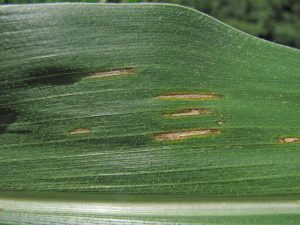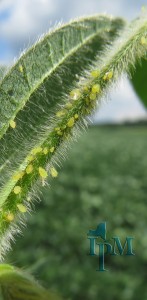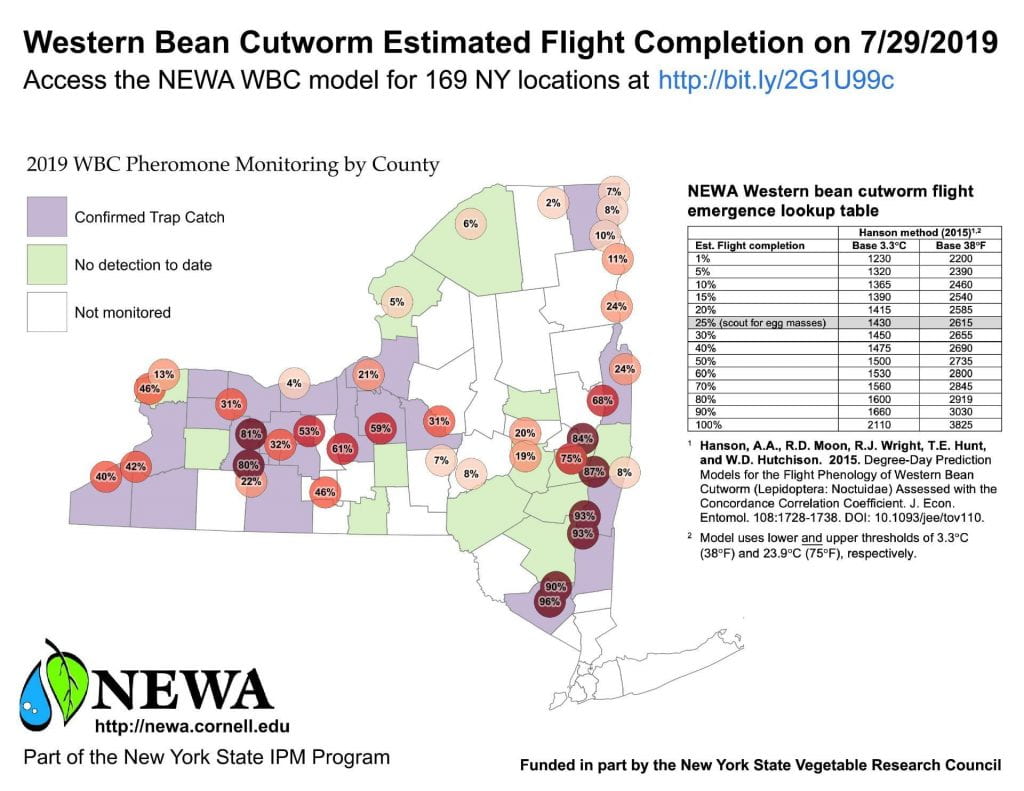NYS IPM Weekly Field Crops Pest Report, July 29, 2019
Volume 18, Number 13
View from the Field
Gray Leaf Spot (Cercospora zeae-maydis)
Aaron Gabriel (CCE Capital District) has reported finding a little bit of gray leaf spot in corn. Early symptoms are yellow to tan lesions with a faint watery halo. As the lesion progresses it turns brown and rectangular in shape that exists between the distances of the veins. When fully developed the lesion can be 3 to 4 inches long and a 1/6 to 1/8 inch wide. The fungus can overwinter on corn debris left on the soil surface. Spores develop when it starts getting warm and the humidity started to rise in late spring. The spores can be transmitted by both wind and rain. In some cases, gray leaf spot can limit yield up to 5 to 40 bushels of corn per acre. Currently, it is not widespread but when you are out scouting look for these lesions on the leaves.
Soybean Aphids (Aphis glycines)
There were reports of soybean aphids starting to show up in soybeans. While the populations are low, they can increase. SBAs are a very tiny soft-bodied insect. They are pale yellow-green and less that 1/16 of an inch long. The aphid has black cornicles, aka “tail pipes” on hind end of the insect. Most generations of SBA lack wings with the exception of early field invaders and a population readying for migration or dispersal. They are the ONLY aphids that infest soybeans in North America.
Remember the 250 aphids/plant economic threshold is between the R1 and R5 stage of soybean growth. After the R5 stage of growth, research has shown control is not necessary.
Potato Leafhopper (Empoasca fabae)
There are continued reports of potato leafhopper (Empoasca fabae) (PLH) over threshold in several fields across NY. For information on scouting/monitoring PLH in alfalfa, view the following video: IPM for potato leafhopper in alfalfa-Video
Weather Outlook – July 25, 2019
Jessica Spaccio
NOAA Northeast Regional Climate Center, Cornell University
Last week temperatures ranged from near normal to 4 degrees above normal. Precipitation has ranged from a tenth of an inch to near 3 inches. Base 50 growing degree-days ranged from 100 to 180.
Last week temperatures ranged from 2 to 4 degrees above normal. Precipitation has ranged from a hundredth of an inch to near 4 inches. Base 50 growing degree-days ranged from 110 to 210.
A mostly dry period, with the exception for isolated afternoon thunderstorms, and temperatures warming through the weekend. Next major precipitation will be Tuesday into Wednesday.
Today will be mostly sunny & dry, some isolated afternoon thunderstorms are possible, with temperatures in the mid 70s to mid 80s. Overnight lows will be in the mid 50s to mid 60s.
Friday temperatures will be in the 80s with sunny conditions. Overnight temperatures will be in the 60s.
Saturday temperatures will be in the mid to upper 80s with dry conditions. Overnight temperatures will be in the 60s.
Sunday highs will be in the mid to upper 80s with increasing humidity and a slight chance of isolated afternoon thunderstorms. Overnight temperatures will be in the 60s.
Monday temperatures will be in the mid to upper 80s, near 90. Overnight temperatures will be in the mid 60s to low 70s.
Tuesday highs will be in the 80s, some low 90s possible, with showers and thunderstorms possible with a passing slow-moving cold front. Overnight temperatures will be in the mid 60s to low 70s.
Wednesday highs will be in the 80s with lingering showers and thunderstorms. Overnight temperatures will be in the 60s.
The seven-day precipitation amounts will range from a quarter inch to one and a quarter inch.
The 8-14 day outlook (August 1-7) favors above-normal temperatures for all but western NY. The outlook favors above-normal precipitation for all of the state.
National Weather Service watch/warnings map
Western Bean Cutworm Data
Clipboard Checklist
Keith Waldron, NYS IPM
General
*Walk fields to check general field condition, weed, vertebrate and other issues
*Watch for crop maturity, stand assessments, weed escapes, nutrient deficiencies, lodging issues
Alfalfa:
*Evaluate established legume stands for approximate days until harvest
*Monitor potato leafhopper, foliar, systemic and crown rot diseases.
*Monitor new seedings for potato leafhopper, pythium blight, phytopthora root rot.
Small Grains:
*Monitor grain fields for growth stage, disease and lodging issues, grain maturity, harvest timing
*Record diseases present, location and types of weed escapes
Corn:
*Monitor for mid-season corn pests including European corn borer, corn rootworm, western bean cutworm, slugs, foliar diseases such as northern corn leaf blight and gray leaf spot, weed issues, nutrient deficiencies, vertebrate damage.
Soybeans:
*Monitor for soybean aphid, defoliators, foliar diseases, white mold, weed issues, vertebrate damage
Pastures:
*Check water sources, mend fences as needed.
*Check crop growth, clip pastures between grazing as needed
*Monitor for invasive species, plants harmful to livestock
*Review/Plan rotations
Storage:
* Check stored grain bins for temperature, moisture and signs of mold and insects. Aerate, core, transfer grain or treat as necessary
* Clean and disinfect empty storage bins in preparation for grain harvest
*Check forage allocation and anticipate feed program adjustments as forages from previous year are used up
*Mow around storage bins and facility to minimize pest hiding places
Dairy Cattle Barn Fly Management:
*Monitor animals and barn area for house fly, stable fly and other pest management needs including presence of rodents and birds.
*Check facilities for favorable fly breeding conditions: (organic matter + moisture): leaks in watering systems, roof gutters for leaks and potential overspill, drainage,
*Sanitation, sanitation, sanitation – clean animal resting areas, feed troughs, minimize source of moist organic matter i.e. fly breeding areas in barn and in adjacent animal loafing yard
* Continue fly monitoring: install “3X5″ index card fly speck monitoring cards throughout barn
*Use, replenish, replace fly management materials: sticky fly tapes/ribbons, insecticide baits, natural enemies (parasitoids), fly population monitoring (3 x 5) spot cards
*Consider purchase and release of Muscidifurax raptor and/or M. raptorellus natural enemies of house and stable fly pupae.
Dairy Cattle on Pasture:
*Monitor animals for presence of face flies, horn flies and stable flies. Action guidelines: face flies (average 10 per animal face), horn flies (average 50 / dairy per animal side, 200 / beef cattle per animal side), stable flies average 10 per animal (all four legs)
*Check feed bunk / water source locations for signs of stable fly breeding (moist undisturbed organic matter – spilled feed, round bales, etc.), minimize source of moist organic matter i.e. fly breeding areas in barn and in adjacent animal exercise yard.
*Check pasture for forage quality / quantity, rotate as appropriate
*Check pasture for vegetation poisonous to livestock
*Consider use of pasture fly traps to help reduce deer, horse and stable fly populations




